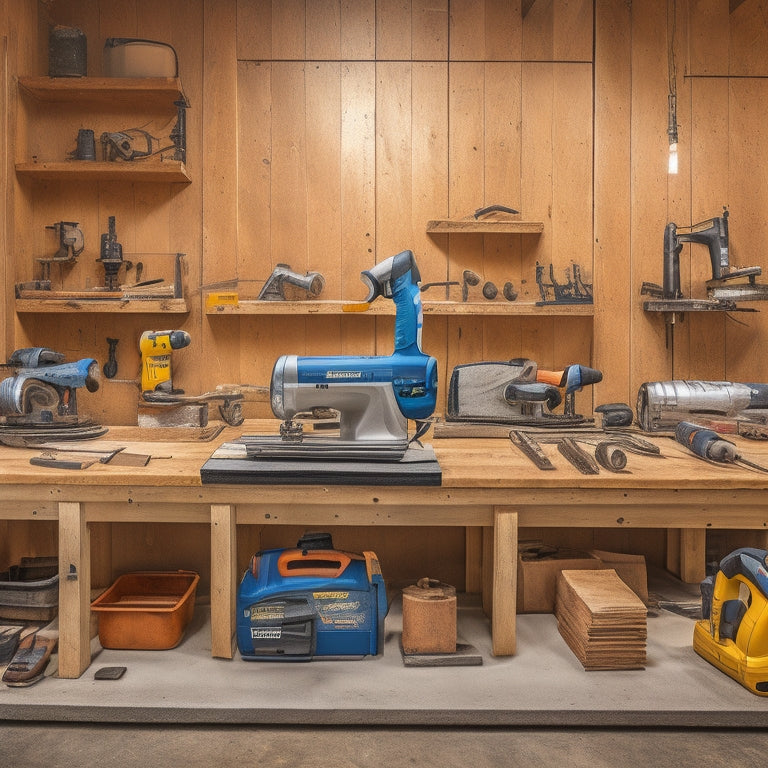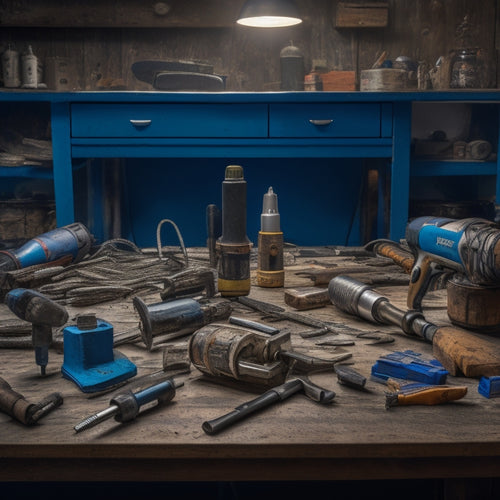
7 Best Power Tools for Wall Repair and Renovation
Share
You'll need the right power tools to tackle your wall repair and renovation project efficiently. For drilling and driving, consider a power drill with adjustable speed and torque control, and an impact driver for high-torque screw driving. A rotary hammer is essential for heavy-duty drilling and demolition, while a demolition hammer is perfect for tough demolition jobs. Don't forget a reciprocating saw for precise cuts and demo work in tight spaces. Additionally, look for features like ergonomic design, noise reduction, and brushless motors for increased efficiency. With the right tools and knowledge, you'll be well-equipped to tackle your project - and we'll help you get started.
Key Takeaways
• Identify the right power drill and drill bit for the job, considering speed settings, torque control, and material compatibility.
• Select a rotary hammer or impact driver based on the type of wall repair, ensuring compatibility with drill bits and suitable weight for the project.
• Choose a power source that meets the project's power needs, considering motor type, voltage, and amps, as well as battery life and recharge time.
• Consider a demolition hammer for heavy-duty demolition jobs and a reciprocating saw for efficient cutting and demo work in tight spaces.
• Ensure the tools provide ergonomic design, adjustable settings, and safety features to reduce user fatigue and enhance overall performance.
Understanding Wall Repair Requirements
When evaluating wall damage, you're likely dealing with cracks, holes, or water damage that requires a thoughtful approach to repair. This involves a thorough evaluation of the affected area to determine the necessary materials and tools.
A detailed wall damage evaluation is essential to identify the root cause of the issue and decide on the best course of action. This includes inspecting the wall's structural integrity, checking for signs of moisture or pest infestation, and examining the extent of the damage.
Next, you'll need to compare different repair materials to choose the most suitable one for your specific situation. This might include drywall compound, joint tape, or specialized products for water-damaged areas.
You may also need to take into account the type of paint or finish required to match the surrounding area. By taking the time to properly evaluate the damage and select the right materials, you'll guarantee a strong, long-lasting repair that withstands the test of time.
With a clear understanding of your wall repair requirements, you'll be well-equipped to tackle the job efficiently and effectively.
Choosing the Right Power Drill
When choosing the right power drill for wall repair, you'll need to take into account the type of drill bits you'll be using, as different bits require specific drill characteristics.
You'll want to select a drill that offers adjustable speed and torque control to guarantee precise hole placement and prevent damage to surrounding material.
Drill Bit Selection
You'll need to select the right drill bit for your power drill, as it greatly impacts the quality of your wall repair job. The wrong drill bit can lead to poor hole quality, reduced accuracy, and even damage to the surrounding material.
When choosing a drill bit, take into account the type of material you'll be working with and the size of the hole you need to create.
Here are some key factors to take into account when selecting a drill bit:
-
Drill bit materials: Carbon steel bits are suitable for drilling through drywall and wood, while high-speed steel (HSS) bits are better for drilling through metal and concrete. Diamond-coated bits are ideal for drilling through tile and glass.
-
Drill bit sizes: Choose a drill bit that matches the size of the screw or anchor you'll be using. Common sizes range from 1/16 inch to 1/2 inch.
-
Point angle: A 90-degree point angle is best for drilling through wood and drywall, while a 130-degree point angle is better for drilling through metal.
- Coating: Consider a drill bit with a coating, such as titanium or bronze, to reduce friction and increase drill bit lifespan.
Speed and Torque Control
With the right drill bit in hand, it's now time to contemplate the power drill itself, as its speed and torque control will greatly influence the quality of your wall repair job. You'll want a drill that offers variable speed settings, allowing you to adjust to the specific task at hand. This is especially vital when working with different materials, such as drywall, wood, or metal.
| Drill Type | Speed Settings | Torque Adjustment |
|---|---|---|
| Cordless Drill | 2-3 settings (low, medium, high) | Electronic torque adjustment |
| Hammer Drill | 3-4 settings (low, medium, high, hammer) | Mechanical torque adjustment |
| Impact Driver | 1-2 settings (low, high) | Electronic torque adjustment |
| Rotary Hammer | 2-3 settings (low, medium, high) | Mechanical torque adjustment |
| Right Angle Drill | 2-3 settings (low, medium, high) | Electronic torque adjustment |
When choosing a power drill, consider the type of projects you'll be working on and the level of torque adjustment you need. Look for drills with intuitive speed settings and torque adjustment mechanisms, such as electronic or mechanical adjustments. This will allow you to fine-tune your drilling experience and achieve professional-grade results.
Selecting a Suitable Rotary Hammer
When selecting a suitable rotary hammer for your wall repair project, you'll need to contemplate the type of hammer that's best suited for the task at hand.
You'll also want to think about the drill bits you'll need to get the job done efficiently.
Hammer Type Considerations
Selecting a suitable rotary hammer for wall repair depends on the type of hammer you need, as different models excel in specific tasks, such as drilling, chiseling, or demolition.
You'll want to evaluate the hammer type that best fits your project requirements.
When choosing a rotary hammer, assess the following key factors:
-
Hammer weight: Lighter hammers are ideal for smaller tasks and overhead work, while heavier hammers provide more power for demanding projects.
-
Hammer types: Rotary hammers come in three main types: SDS-Plus, SDS-Max, and rotary hammer drills. Each type has its own unique characteristics, such as bit compatibility and motor power.
-
Power source: Decide between corded or cordless models, depending on your mobility and power needs.
- Additional features: Some rotary hammers come with features like adjustable torque, variable speed, and LED lights, which can enhance your overall performance and accuracy.
Drill Bit Selection
Drilling into concrete, brick, or block requires choosing the right drill bits, as the wrong ones can lead to tool damage, reduced efficiency, or even safety hazards.
When selecting a suitable rotary hammer, you'll want to take into account the type of material you're working with and the specific task at hand. Different drill bit materials are designed for specific applications, such as carbide-tipped bits for concrete and masonry, or diamond-coated bits for tile and glass.
You'll also need to choose the right drill bit size for the job. Larger bits are typically used for anchoring and demolition, while smaller bits are better suited for precision drilling.
Take into account the diameter and length of the bit, as well as the shank type, which can be SDS, SDS-Plus, or spline. Make sure the bit is compatible with your rotary hammer's chuck type to guarantee smooth operation and maximum power transfer.
Power Source Options
You'll need to contemplate the power source and motor type of your rotary hammer, as cordless models offer greater portability and convenience, while corded models provide consistent power and reliability.
When choosing between cordless options, assess the battery life and recharge time to guarantee it meets your project's demands. A longer battery life may be essential for extensive wall repair projects, while faster recharge times can minimize downtime.
Here are key factors to weigh when selecting a suitable rotary hammer:
-
Motor Type: Brushless motors provide increased efficiency and longer lifespan, while brushed motors are more affordable.
-
Voltage and Amps: Higher voltage and amps translate to more power, but may also increase weight and reduce battery life.
-
Battery Life and Recharge Time: Opt for a rotary hammer with a battery life that matches your project's requirements, and assess fast-charging capabilities to minimize downtime.
- Weight and Ergonomics: A lightweight and ergonomic design can reduce fatigue and improve overall performance.
Importance of a Good Impact Driver
A good impact driver proves indispensable when tackling wall repair projects that require efficient and effective screw driving, especially when working with dense or hardwood materials.
You'll appreciate the benefits of an impact driver when working with heavy screws or driving into thick wood. The sheer torque and power of these tools make quick work of even the most stubborn screws. Plus, many impact driver brands, such as DeWalt and Makita, offer ergonomic designs that reduce fatigue and improve control.
When choosing an impact driver, consider the impact driver benefits that matter most to you. Do you need high torque for heavy-duty projects or precision control for delicate tasks?
Look for features like adjustable torque settings, LED lights, and built-in level indicators to guarantee you're getting the right tool for the job. With an impact driver in your arsenal, you'll be able to tackle wall repair projects with confidence and ease.
Buying a Reliable Demolition Hammer
When you're tearing down old walls or breaking up existing structures, a reliable demolition hammer becomes your go-to tool for efficient removal of materials. With the right demolition hammer, you'll be able to tackle even the toughest demolition jobs with ease. But with so many options on the market, it can be overwhelming to select the right one.
Here are some key factors to take into account when buying a reliable demolition hammer:
-
Demolition hammer types: There are several types of demolition hammers, including electric, pneumatic, and hydraulic. Each type has its own strengths and weaknesses, so it's important to choose the one that best fits your needs.
-
Power output: Look for a demolition hammer with a high power output to guarantee you can tackle tough demolition jobs.
-
Weight and ergonomics: A lightweight demolition hammer with ergonomic design will reduce fatigue and improve control.
- Safety precautions: Always wear protective gear, including safety glasses, gloves, and a dust mask, when operating a demolition hammer.
Picking the Perfect Reciprocating Saw
For efficient cutting and demo work, selecting the perfect reciprocating saw is essential, as it will help you navigate tight spaces and make precise cuts with ease.
You'll want to evaluate the reciprocating saw benefits that matter most to you, such as speed, power, and versatility.
When it comes to blade types, you've got options. Bi-metal blades offer a balance of speed and durability, while carbide-tipped blades are ideal for heavy-duty demo work. You may also want to examine blades with specialized coatings, like titanium or diamond, for improved performance.
When choosing a reciprocating saw, think about the specific tasks you'll be tackling. Will you be cutting through wood, metal, or drywall? Different materials require different blade types and saw settings.
Assess the stroke length and speed of the saw, as well as its weight and ergonomics. A comfortable, well-balanced saw will reduce fatigue and improve your overall performance.
Considering Additional Power Tool Features
You'll also want to contemplate additional power tool features that can enhance your wall repair efficiency, such as LED lights, adjustable handles, and built-in level functions. These features may not be essential, but they can notably improve your overall experience and productivity.
Here are some key features to ponder:
-
Ergonomic design: Look for tools with contoured grips and balanced weight distribution to reduce fatigue and improve control.
-
Noise reduction: If you plan to work in noise-sensitive areas, reflect on tools with built-in noise reduction features or those that operate at lower decibel levels.
-
Brushless motors: These motors offer increased efficiency, reduced maintenance, and improved performance.
- Battery life indicators: Tools with battery life indicators can help you avoid running out of power mid-project and guarantee you're always prepared.
Frequently Asked Questions
Can I Use a Power Tool With a Damaged or Frayed Cord?
When you're about to use a power tool, don't risk your safety - inspect the cord first. If it's damaged or frayed, don't even think about plugging it in.
You're playing with fire, literally. Cord maintenance is key to tool safety. A worn-out cord can cause electrical shocks, fires, or even tool failure.
Replace the cord or get it repaired by a pro. Your safety is worth the extra effort.
How Do I Prevent Overheating in My Power Tools?
Did you know that 30% of power tool failures are due to overheating? To prevent this, you're taking a smart step.
Overheating causes include blocked air vents, worn-out brushes, and excessive load.
Follow tool maintenance tips like regular cleaning, storing tools in a dry place, and monitoring workload.
Additionally, keep an eye on your tool's temperature gauge and take regular breaks to let it cool down.
Are Power Tools With Lithium-Ion Batteries Worth the Investment?
You're wondering if power tools with lithium-ion batteries are worth the investment. The answer is yes!
Lithium-ion batteries offer significant advantages, including longer battery longevity and reduced self-discharge rates. This means you'll get more runtime and fewer recharges.
Additionally, lithium-ion batteries are more durable and resistant to wear and tear, making them a reliable choice for demanding projects.
Can I Use Power Tools in Areas With High Moisture Levels?
When you're working in areas with high moisture levels, you'll want to take humidity precautions seriously.
You can't just use any power tool - you need moisture-resistant tools designed to withstand the wet conditions.
Look for tools with IP67 or higher ratings, which guarantee protection against water and dust.
Additionally, consider tools with sealed batteries and water-resistant casings to minimize the risk of electrical shock or damage.
What Safety Gear Is Essential When Operating Power Tools?
When operating power tools, you'll need essential safety gear to protect yourself from hazards.
You're required to wear safety goggles to shield your eyes from debris and dust.
Additionally, hearing protection is a must to prevent permanent damage from loud machinery.
Don't compromise your well-being - invest in high-quality gear that meets industry standards.
Conclusion
You've made it through the gauntlet of wall repair and renovation tools - congratulations!
Now, you're probably itching to get started on that DIY project, armed with the perfect arsenal of power tools.
Ironically, the most vital step is yet to come: not messing up the actual repair.
But with these 7 essential power tools, you'll be well-equipped to tackle even the most intimidating tasks.
Just remember, it's not just about having the right tools - it's about not becoming a DIY disaster story.
Related Posts
-

Crack Repair Inspection Checklist for Home Renovation
When creating a crack repair inspection checklist for your home renovation project, you'll want to identify crack typ...
-

5 Must-Have Plastering Tools for Safe Renovation
You'll need a range of essential tools to tackle your plastering project safely. Invest in a variety of trowels, incl...
-

What to Look for in Pneumatic Renovation Tools
When selecting pneumatic renovation tools, you'll want to take into account several key factors to guarantee optimal ...


